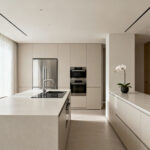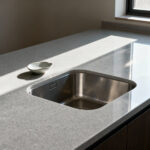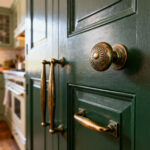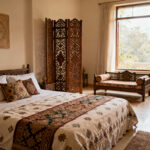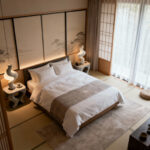Picture this: You’re standing at the threshold of your dining room, sunlight streaming through the windows, casting a warm glow on the rich, honeyed tones of your hardwood floor. The scent of polish lingers in the air, a testament to years of care and cherished memories. This dear readers, is the timeless allure of hardwood dining room flooring – a design choice that’s as much about creating a legacy as it is about aesthetics.
As an urban planner with a passion for historic preservation, I’ve wandered through countless dining rooms, from quaint Milwaukee bungalows to grand Chicago mansions. And let me tell you, nothing quite captures the essence of a well-designed dining space like the enduring beauty of hardwood floors. They’re like the perfect dinner guest – warm, inviting, and always in style.
But before we dive into the delicious details of hardwood dining room flooring, let’s set the table, shall we? If you’re hungry for more options, you might want to check out the ultimate guide to dining room flooring. It’s a smorgasbord of flooring ideas that’ll satisfy even the pickiest design palate. Now, let’s dig in!

Key Takeaways: The Appetizer Course
Before we serve up the main course, let’s whet your appetite with some tasty tidbits about hardwood dining room flooring:
- Hardwood floors are the comfort food of interior design – timeless, satisfying, and always in demand.
- From oak to exotic woods, there’s a flavor for every taste. Choose wisely, and your floors will age like fine wine.
- The right finish isn’t just pretty – it’s your floor’s suit of armor against dinner party disasters.
- Plank sizes and patterns are the secret ingredients that can make your dining room feel cozy or grand.
- Like any good relationship, hardwood floors need love and care to stand the test of time.
- Investing in hardwood dining room flooring is like buying a little piece of real estate gold – it never goes out of style.
Benefits of Hardwood in Dining Rooms: The Main Course
Let me paint you a picture: It’s a crisp autumn evening in Milwaukee. You’re hosting a dinner party, and as your guests step into your dining room, their eyes are immediately drawn to the gleaming expanse of hardwood beneath their feet. The rich, amber tones of the wood create an instant atmosphere of warmth and sophistication. It’s like your floor is giving everyone a big, welcoming hug.

Hardwood dining room flooring isn’t just a surface to walk on – it’s the foundation of your room’s entire ambiance. It’s the difference between a dining room that feels like a stuffy restaurant and one that feels like home. The natural variations in the wood grain tell a story, adding depth and character to your space that no man-made material can quite match.
Natural Ambiance: Bringing the Outdoors In
There’s something almost magical about the way hardwood connects us to nature, even in the heart of the city. I’ve seen it transform urban dining rooms into cozy woodland retreats. The organic patterns and textures of hardwood dining room flooring create a sense of calm and groundedness – perfect for those long, leisurely dinners where conversation flows as smoothly as wine.
And let’s talk about light for a moment. The way natural light plays across a hardwood floor is nothing short of poetry. It changes throughout the day, bringing your dining room to life in ways that static flooring materials simply can’t match. It’s like having a built-in mood lighting system, courtesy of Mother Nature herself.
Long-term Investment: A Floor That Pays Dividends
Now, let’s get down to brass tacks. As someone who’s seen her fair share of home renovations, I can tell you that hardwood dining room flooring is more than just a pretty face – it’s a smart financial move. It’s like the blue-chip stock of the flooring world. Sure, the initial investment might be higher than some alternatives, but the long-term payoff is worth its weight in gold (or should I say, wood?).

Hardwood floors have staying power. They can last for generations with proper care, often outliving trends and even homeowners. This longevity translates to real value for your home. I’ve seen properties where the original hardwood floors were a major selling point – sometimes even the deciding factor for buyers.
Allergy-Friendly Choice: A Breath of Fresh Air
In my years of urban planning, I’ve become increasingly aware of the importance of indoor air quality. Hardwood dining room flooring is a breath of fresh air in this regard – quite literally. Unlike carpets, which can trap allergens and dust, hardwood floors are easy to clean and don’t harbor irritants.
For families dealing with allergies or asthma, this can be a game-changer. Imagine being able to enjoy your meals without worrying about what’s lurking in your flooring. It’s like giving your dining room a clean bill of health.
Types of Wood Species: Choosing Your Perfect Match
When it comes to hardwood dining room flooring, oak, and maple are like the Romeo and Juliet of the wood world – a classic pairing that never goes out of style. Oak, with its prominent grain and timeless appeal, is the darling of traditional homes. It’s like the little black dress of flooring – always appropriate, always elegant.

Maple, on the other hand, is the rising star of contemporary design. Its lighter tones and subtle grain make it perfect for modern dining rooms. It’s like the crisp white shirt of the wood world – clean, fresh, and endlessly versatile.
Both of these woods are tough cookies, standing up well to the hustle and bustle of family dinners and holiday gatherings. They’re the kind of flooring that can take a beating and still look beautiful – much like those vintage Milwaukee factories that have been repurposed into stunning loft spaces.
Cherry and Walnut: The Sophisticated Duo
Now, if you’re looking to add a touch of luxury to your dining room, cherry and walnut are your go-to woods. Cherry is like a fine wine – it gets better with age. Its color deepens over time, developing a rich, warm patina that’s simply irresistible. I once saw a cherry hardwood dining room flooring in a historic home that was over a century old, and let me tell you, it was breathtaking.
Walnut, with its deep, chocolate tones, is the brooding poet of hardwoods. It adds instant drama and sophistication to any dining space. It’s perfect for creating a cozy, intimate atmosphere – ideal for those candlelit dinners or late-night conversations over a bottle of red.

Exotic Choices: The Conversation Starters
For those who like to walk on the wild side, exotic hardwoods offer a world of possibilities. Woods like Brazilian cherry or teak can turn your dining room floor into a work of art. But a word of caution: with great beauty comes great responsibility. When choosing exotic hardwoods, it’s crucial to consider sustainability and ethical sourcing.
I once worked on a project where we used reclaimed teak from old sailing ships for the dining room floor. Not only was it stunning, but it also had a story to tell – a real conversation starter during dinner parties.
Comparing Durability: The Tough Cookie Contest
When it comes to durability, not all hardwoods are created equal. This is where the Janka hardness scale comes in handy. It’s like a toughness test for wood, measuring how well different species resist dents and wear.
Oak and maple, our classic sweethearts, rank high on this scale, making them great choices for busy dining rooms. Softer woods like pine might not be the best choice unless you’re going for that “well-loved” look right from the start.
Remember, choosing the right hardwood for your dining room is like finding the perfect wine pairing – it should complement your lifestyle and taste while standing up to whatever you dish out.

Choosing the Right Finish: The Secret Sauce
Choosing the right finish for your hardwood dining room flooring is like putting the perfect glaze on a cake – it can make or break the final look. Let’s start with the glossy finish. It’s the glamour queen of the flooring world, reflecting light and adding a touch of elegance to your dining space. A glossy finish can make your wood floors look like they’re straight out of a magazine spread.
But before you get stars in your eyes, consider the practicality. Glossy floors, while beautiful, can show every speck of dust and every footprint. They’re like that friend who always looks impeccable – stunning, but high-maintenance.
On the flip side, we have matte finishes. These are the cool, understated cousins of the glossy finish. They have a more natural, organic look that’s particularly well-suited to rustic or farmhouse-style dining rooms. Matte finishes are also more forgiving when it comes to hiding scratches and imperfections. They’re like that effortlessly chic friend who always looks put-together, even in jeans and a t-shirt.
Stain Options: Painting with Nature’s Palette
Now, let’s talk about stains. Choosing a stain for your hardwood dining room flooring is like being an artist with a giant canvas. You have the power to dramatically alter the look of your wood, from light and airy to rich and dramatic.

Light stains can make your dining room feel more spacious and airy – perfect for smaller spaces or rooms with limited natural light. Dark stains, on the other hand, can add a sense of coziness and intimacy. I once worked on a project where we used a dark walnut stain on oak floors in a large, open-plan dining area. The result was stunning – it visually anchored the space and created a sense of warmth that balanced out the room’s grand scale.
Don’t forget about natural finishes either. Sometimes, the most beautiful option is to simply enhance the wood’s natural color and grain. It’s like letting the wood tell its own story.
Protective Coatings: The Invisible Shield
Last but certainly not least, let’s discuss protective coatings. This is the unsung hero of hardwood dining room flooring – the invisible shield that guards against spills, scratches, and everyday wear and tear.
Polyurethane is a popular choice, offering excellent protection in both water-based and oil-based formulations. Water-based poly dries quickly and maintains the wood’s natural color, while oil-based poly adds a slight amber tint that deepens over time.
For those looking for a more natural option, hard wax oils are gaining popularity. They penetrate the wood, enhancing its natural beauty while protecting within. Plus, they’re easier to touch up than traditional polyurethane finishes.

Remember, the right protective coating can mean the difference between floors that look great for a few years and floors that become family heirlooms. Choose wisely!
Plank Sizes and Patterns: The Design Buffet
When it comes to hardwood dining room flooring, size does matter – plank size, that is. It’s like choosing between a delicate appetizer and a hearty main course. Both have their place, but they create very different dining experiences.
Wide planks, typically 5 inches or more in width, are like the bold statement pieces of the flooring world. They can make a space feel larger and more open, perfect for creating a sense of grandeur in your dining room. I once worked on a restoration project for a historic mansion in Chicago where we used 12-inch wide reclaimed barn wood planks in the dining room. The effect was stunning – it gave the room a sense of history and gravitas that perfectly complemented the home’s architectural style.
On the other hand, narrow planks (2-3 inches wide) offer a more traditional look. They’re like the fine details in a painting – they add visual interest and can make a space feel more intimate. Narrow planks are great for smaller dining rooms or for creating a more formal atmosphere.
Popular Patterns: From Classic to Contemporary
Now, let’s talk patterns. The way you arrange your hardwood dining room flooring can completely transform the look and feel of your space. It’s like composing a visual symphony right under your feet.

The classic straight lay is like the steady bass line – reliable and timeless. It’s a great choice if you want your floors to be a beautiful backdrop rather than the star of the show.
For those looking to add a touch of sophistication, consider a herringbone or chevron pattern. These geometric designs add visual interest and a sense of movement to your dining room. I once saw a dining room with a light oak herringbone floor that looked like it was straight out of a Parisian apartment – très chic!
Don’t forget about borders and inlays either. A contrasting wood border around the perimeter of your dining room can frame the space beautifully, while an inlay in the center can create a stunning focal point. It’s like adding a beautiful frame to a precious painting.
Impact on Room Size: Optical Illusions Underfoot
The size and pattern of your hardwood dining room flooring can have a significant impact on how large or small your space feels. It’s like a magic trick for your eyes.
Generally, wider planks and lighter colors can make a room feel larger and more open. If you have a small dining room, consider wide planks in a light oak or maple. Install them parallel to the longest wall to elongate the space.
For larger dining rooms, you have more flexibility. You could go bold with a dark, wide-plank floor to create a sense of coziness or use a herringbone pattern to add visual interest to a large expanse of floor.

Remember, the direction of your planks matters too. Installing planks diagonally can make a room feel larger and more dynamic. It’s like adding a dash of unexpected spice to your favorite recipe – it can liven things up!
Pros and Cons: Weighing Your Options
Let’s face it – one of the biggest pros of hardwood dining room flooring is its sheer beauty. It’s like having a piece of natural art right under your feet. The rich colors, the unique grain patterns, the way it changes and develops character over time – it’s simply unmatched.
Hardwood floors have a chameleon-like quality, able to complement any design style. Whether your dining room is traditional, modern, rustic, or eclectic, there’s a hardwood floor that will fit right in. It’s like the perfect little black dress of the design world – it goes with everything.
But beauty isn’t just skin deep when it comes to hardwood. These floors have substance too. They add warmth and character to a space in a way that luxury vinyl plank dining room flooring or laminate simply can’t match. It’s the difference between a reproduction and an original painting – there’s just something special about the real thing.
Maintenance Needs: The Price of Beauty
Now, let’s talk about the elephant in the room – maintenance. Hardwood dining room flooring, for all its beauty, does require some TLC. It’s like owning a classic car – gorgeous, but you can’t just ignore it and expect it to stay that way.

Regular cleaning is a must. We’re talking sweeping or vacuuming to remove dirt and grit that can scratch the surface, and occasional mopping with a wood-appropriate cleaner. It’s not rocket science, but it does require consistency.
Then there’s the matter of refinishing. Depending on the wear and tear, you might need to refinish your floors every 5-10 years. It’s like giving your dining room a facelift – a bit of effort, but the results can be spectacular.
Water is the arch-nemesis of hardwood floors. Spills need to be wiped up promptly to prevent damage. If you’re the type who likes to water your dining room plants with abandon, you might want to reconsider your flooring choice (or your plant-watering habits).
Resistance to Damage: Tough but Not Invincible
Hardwood dining room flooring is tough, but it’s not indestructible. It’s like a seasoned boxer – it can take a few hits, but it’s not immune to damage.
Scratches and dents can happen, especially in high-traffic areas or under the legs of heavy dining chairs. Some woods (like oak and maple) are harder and more resistant to this type of damage than others.
On the plus side, minor scratches often add character to hardwood floors. It’s like the patina on an antique piece of furniture – it tells a story. And for more serious damage, hardwood has a secret weapon: it can be sanded and refinished, something that can’t be done with many other flooring types.

UV rays can cause some woods to fade or change color over time. It’s like a slow, natural aging process. Some people love this evolution, seeing it as part of the floor’s story. Others might prefer to use UV-resistant finishes or strategically place rugs to minimize this effect.
Despite these considerations, hardwood dining room flooring remains a popular choice for its overall durability and longevity. It’s like investing in a piece of fine art – with proper care, it can last for generations.
Maintenance Tips: Keeping Your Floors Fine and Dandy
Maintaining your hardwood dining room flooring is like tending to a beloved garden – a little regular care goes a long way. Let’s start with the daily routine, shall we?
First things first: sweep or vacuum regularly. It’s like brushing your teeth – a daily habit that prevents bigger problems down the line. Use a soft-bristled broom or a vacuum with a floor-brush attachment to gently remove dirt and debris. Imagine you’re sweeping away the day’s worries along with the dust – therapeutic, isn’t it?
For deeper cleaning, damp-mop your floors weekly or as needed. But here’s the kicker – when I say damp, I mean barely moist. Your mop should be about as wet as a Milwaukee summer morning – just a hint of moisture. Use a cleaner specifically designed for hardwood floors. Avoid harsh chemicals or excessive water – they’re about as welcome on your hardwood as a bull in a china shop.

Preventing Scratches: An Ounce of Prevention
Now, let’s talk about protecting your floors from scratches. It’s like childproofing your home, except you’re guarding against chairs, high heels, and the occasional dropped fork.
Start by placing felt pads under the legs of your dining chairs and table. It’s a small step that can make a big difference. Consider implementing a “no shoes” policy in your dining room – it’s not just a cultural practice, it’s a floor-saving technique!
Area rugs can be your secret weapon in high-traffic areas. They’re like body armor for your floors, absorbing the impact of daily use. Just make sure to use rug pads to prevent slipping and to allow your floor to breathe.
Seasonal Care: Changing with the Times
Just like our beloved Milwaukee weather, hardwood floors can be affected by seasonal changes. It’s all about managing moisture and humidity.
In the winter, when our heaters are working overtime, the air can get drier than a Thanksgiving turkey left in the oven for too long. This can cause your hardwood to contract, potentially leading to gaps between planks. A humidifier can help maintain optimal moisture levels.
Come summer, when the humidity rises faster than the mercury, your floors might expand. Keeping your home cool and using a dehumidifier can prevent excessive swelling.

Remember, consistency is key. Try to maintain a relatively stable environment in your dining room throughout the year. It’s like creating a mini-ecosystem for your floors – they’ll thank you for it by staying beautiful year after year.
Enhancing Home Value: The Long Game
Let’s talk about the elephant in the room – or should I say, the hardwood in the dining room. When it comes to enhancing your home’s value, hardwood dining room flooring is like the little black dress of the design world – always in style, always elegant.
I’ve seen trends come and go faster than you can say “shag carpet,” but hardwood floors? They’re the constant in an ever-changing design landscape. It’s like investing in a classic piece of art – its value only appreciates over time.
The beauty of hardwood is its chameleon-like ability to adapt to any style. Whether your dining room is a modern minimalist haven or a traditional space filled with family heirlooms, hardwood flooring provides the perfect backdrop. It’s like a versatile actor who can play any role convincingly.
Market Appeal: Selling Points That Shine
Now, let’s put on our real estate goggles for a moment. When it comes time to sell your home (not that you’d ever want to leave your beautiful hardwood-floored dining room), those gleaming planks can be a major selling point.
I’ve lost count of the number of times I’ve heard potential buyers gasp in delight when they step into a dining room with well-maintained hardwood floors. It’s like watching someone fall in love at first sight – you can practically see the hearts in their eyes.

Hardwood dining room flooring signals quality and longevity to buyers. It’s a feature that can set your home apart in a sea of wall-to-wall carpeting and different types of tile flooring for dining rooms. In the competitive world of real estate, it can be the detail that tips the scales in your favor.
Moreover, hardwood floors can increase your home’s resale value. It’s like planting a money tree in your dining room – one that grows slowly but surely over the years.
Closing Thoughts: Your Floor, Your Story
As we come to the end of our journey through the world of hardwood dining room flooring, I’m reminded of a beautiful old home I once visited in Milwaukee. The dining room had original hardwood floors that were over a century old. Each scratch, each dent, each subtle color change told a story – of family dinners, of holiday gatherings, of lives well-lived.
Choosing hardwood flooring for your dining room is more than just a design decision. It’s about creating a foundation for your family’s stories. It’s about investing in a feature that will grow and change with you, developing character and patina over the years.
Whether you opt for the classic elegance of oak, the rich tones of walnut, or the unique appeal of exotic wood, remember that your floor is more than just a surface to walk on. It’s a canvas for your life, a stage for your family’s most precious moments.
So go ahead, take the plunge. Choose that hardwood dining room flooring you’ve been dreaming of. As you gather around your table in the years to come, sharing meals and making memories, take a moment to appreciate the beauty beneath your feet. After all, in the grand design of your home, it’s not just about the destination – it’s about enjoying the journey, one step at a time.

